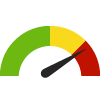Indicator Gauge Icon Legend
Legend Colors
Red is bad, green is good, blue is not statistically different/neutral.
Compared to Distribution
 the value is in the best half of communities.
the value is in the best half of communities.
 the value is in the 2nd worst quarter of communities.
the value is in the 2nd worst quarter of communities.
 the value is in the worst quarter of communities.
the value is in the worst quarter of communities.
Compared to Target
 meets target;
meets target;  does not meet target.
does not meet target.
Compared to a Single Value
 lower than the comparison value;
lower than the comparison value;
 higher than the comparison value;
higher than the comparison value;
 not statistically different from comparison value.
not statistically different from comparison value.
Trend

 non-significant change over time;
non-significant change over time; 
 significant change over time;
significant change over time;  no change over time.
no change over time.
Compared to Prior Value
 higher than the previous measurement period;
higher than the previous measurement period;
 lower than the previous measurement period;
lower than the previous measurement period;
 no statistically different change from previous measurement period.
no statistically different change from previous measurement period.
 Significantly better than the overall value
Significantly better than the overall value
 Significantly worse than the overall value
Significantly worse than the overall value
 No significant difference with the overall value
No significant difference with the overall value
 No data on significance available
No data on significance available
Juvenile Justice Referral Rate
This indicator is archived and is no longer being updated. Click to learn more
Why is this important?
Adolescents who enter the juvenile justice system often have trouble in school and are more likely to experience mental health and substance use issues. Most programs that help decrease arrests and violent crimes in this age group focus on prevention and early intervention (Healthy People 2030). Juvenile referral is an action by which a student is reported to any law enforcement agency or official, including a school police unit, for an incident that occurs on school grounds, during school-related events, or while taking school transportation, regardless of whether official action is taken (U.S. Department of Education).
Considerations for Equitable Approaches: Data on school crime and discipline reflect differences in student experiences in U.S. public schools. When considering their overall enrollment by race/ethnicity, American Indian or Alaska Native students, Black students, White students, and students of two or more races were overrepresented among K-12 students referred to law enforcement in public schools. Students with disabilities were also overrepresented in law enforcement referrals (U.S. Department of Education). In response to racial and ethnic disparities in the different stages of the juvenile justice process, many states have begun to implement reforms by forming working groups with community partners, using regular data collection to guide future efforts, ensuring that race and ethnicity are distinguished from each other in youth surveys, developing more community-based diversion pathways, and enhancing culturally and linguistically competent programs for youth (Interagency Working Group on Youth Programs).
Inclusive Language Recommendations: Recommendations for more inclusive language include utilizing person-first language such as “juveniles who are justice system-involved” (Centers for Disease Control and Prevention) or “persons detained by or under the custody of” rather than “criminals” or “detainee,” which can dehumanize those who are being referred to (Centers for Disease Control and Prevention).
County: St. Louis City
Measurement period: 2022
Maintained by: Conduent Healthy Communities Institute
Last update: November 2024
Graph Selections
Data Source
- Annie E. Casey Foundation
Note: This source uses Zip Code Tabulation Areas (ZCTAs) for its Zip Code data. Learn more
Maintained By: Conduent Healthy Communities Institute (Methodology)
Filed under: Community / Crime & Crime Prevention, Community / Social Environment, Social Determinants of Health, Teens



